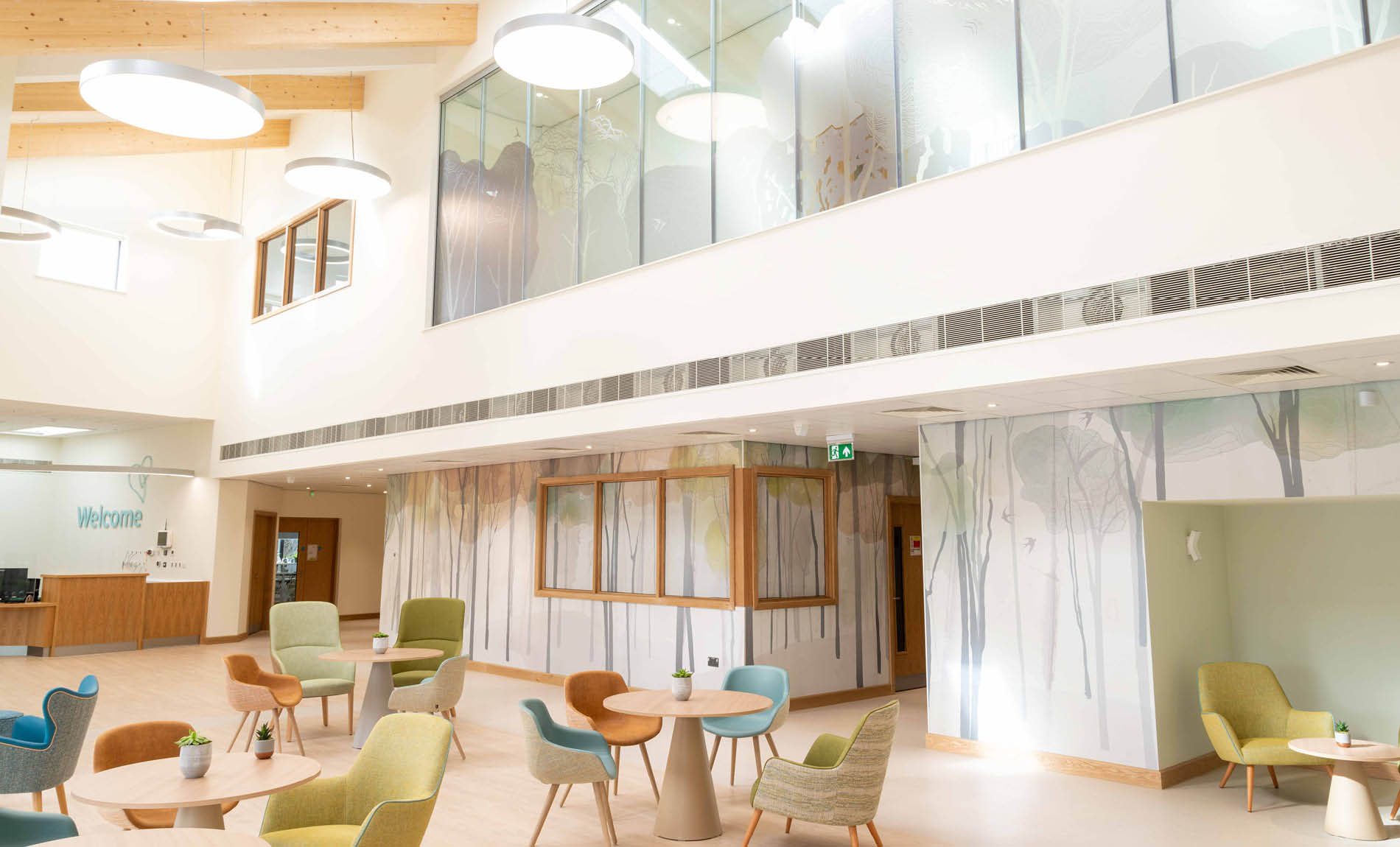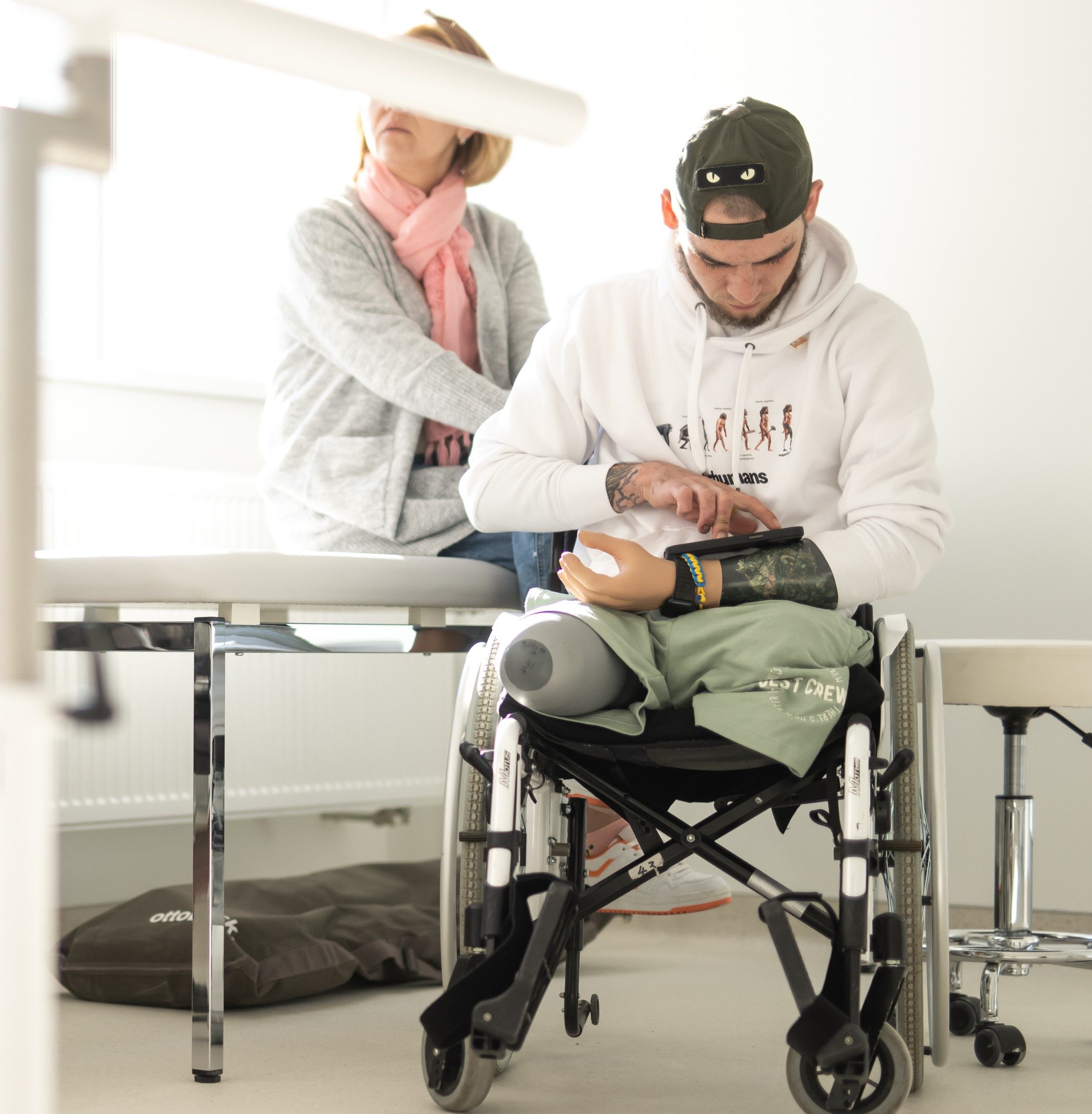Space for Art
The impact of art on health and well-being in healthcare
In this webinar we discussed the impact that considered artwork can have on patient and staff health and well-being, and how NHS Trusts can implement artwork into their healthcare spaces.
The panel included Kate Bond, Surface Designer, Elaine Lewis, Interior Designer, Lisa Harty, Art & Design Manager at Somerset NHS Foundation Trust, and Hetty Dupays, Art & Design Manager at Royal United Hospitals Bath NHS Foundation Trust. Together the team advised on best practice strategies for Trusts with and without integrated arts teams, examining the the practicalities of embedding art into healthcare settings and what more can be done to encourage considered artwork within NHS Trusts.
How do you engage with different users in order to involve their ideas and contributions in artwork?
LISA
Different projects might require different approaches to stakeholder engagement, so there isn’t necessarily a standard format that fits all. In the past we have used workshops, groups and individual meetings, alongside more interactive formats that we are currently developing as part of some design guidance work.
HETTY
At the start of any project the key stakeholders are identified and included in all consultation. Last year we were able to hold interior design and art commissioning workshops for clinical staff to approve proposals for their departments, then feedback is collated and presented at our main project board meetings. A patient representative is included in our art & interior design workstream and we also held several online engagement sessions with patient groups last year. It has been a challenge to include face to face meetings with external groups over the past two years, but we plan to hold workshops with one artist and oncology patients in the coming months, with some artwork to be included in the cancer centre. Ideally, a standard process will be adopted across all NHS Trust commissioning and the National Performance Advisory Group for arts, heritage and design managers are producing tool kits and guidelines to achieve better consistency in this area.
KATE
I have used a mixture of patient engagement workshops and online meetings.
How do you ‘sell in’ art to an NHS Trust? How do you get board approval?
LISA
There are a wealth of examples out there that can be used to demonstrate the impact of art to colleagues in healthcare. There are national lobbying and membership organisations such as AHSW, NPAG and NCCH whose wealth of experience, research and advocacy material tcan be used. From a position of working within a Trust, I would suggest that having clear champions and advocates at senior management and board level are key to understanding and support in involving artwork in healthcare spaces.
HETTY
We have large temporary exhibition spaces which change regularly. Artwork is labelled and priced and includes contact details; we explain the percentage commission, which is fed back into the arts programme. We have just started to take card payments, finally agreeing how to pay the artists’ share without setting them up as ‘contractors’. Because of the frequency of our change overs, and long-standing experience, we generally don’t seek Trust board approval, but I share our exhibition plans at the estates & facilities board meetings. If we have any doubts about suitability, then we will check with relevant directors or departments, such as patient experience, nursing, infection prevention control or fire safety.
ELAINE
Doing a presentation of recent projects and showcasing the portfolio of work to stakeholders is a great way to encourage engagement.
How do you balance the current IPC demands with using different materials for art, fabrics and furniture in interior design?
LISA
We work closely with our IPC team to understand different requirements for different areas and to discuss options.
HETTY
We always seek approval from the IPC team. However, there are many alternatives that can be used in place of traditional materials, such as suitable upholstery fabrics, wall panelling, wall coverings, formats for displaying artworks and acoustic panelling – all of which have come a long way in the past few years. The industry has responded to these restrictions with innovative methods.
KATE
I am always on the lookout for new materials. I went to the Surface Design show and was searching for more eco alternatives. That bit concerns me. I fully understand why hospitals are so strict with regards to infection control, but most options are not so environmentally friendly. Thankfully new options are emerging slowly.
ELAINE
All fabrics, upholstery and furniture used is FR and rated ‘Healthcare’ for highly clinical areas. Sometimes at the clients’ request, the less clinical areas can be relaxed to achieve a ‘less clinical look’.
How can art be implemented into a scheme?
LISA
Different schemes will define when it is appropriate to involve an artist, but the important thing is to ensure that at the beginning of each scheme a clear strategy for an arts project is explored and defined with those involved in developing and delivering the scheme. Not all schemes within the NHS will be appropriate for an arts involvement, but the question should be asked at the very beginning so opportunities are not missed or early involvement isn’t forgotten.
HETTY
Ideally from the outset works best as it is integrated into the design and build, but it is not always the case. Depending on the scheme, budget allowance and timescale, we might be brought in halfway and at the end, but somehow we find a way to bring art into a scheme and make the desired impact. We have to be flexible, quick to respond and push through open doors when we can.
KATE
It depends on the type of project. Elaine and I have worked together on many healthcare projects without an arts manager, but this can make pinning down a brief tricky at times. Without an arts manager, art can be seen as an add-on to a project and therefore not always in the budget. It is best to think about artwork from the start of the project, when the colour palette is developed.
ELAINE
I believe that it is much better to have a discussion about the art on the onset of the design, so it flows with the design and is incorporated early stages. It also helps to see the design as a whole.
How can a Trust add artwork to an existing space effectively?
LISA
I wouldn’t start to answer this until I had looked at the health space in question, how it functions and how those people that use the space feel about it. You would need to explore the potential impact of the artwork on patients and staff once the initial questions have been asked and then you could understand what approach was required.
HETTY
A hospital NHS Trust like ours consists of a mix of older, re-furbished and new builds. 2D artworks are the most straightforward; ‘pictures on walls’ can be achieved anywhere, anytime. Also vinyl manifestations, vinyl wall covering, lit ceilings or light boxes, where there is access to power.
ELAINE
By analysing the existing colour schemes in other areas of the hospital and the space available.
If a Trust doesn’t have an arts team, how can a hospital get artwork in place? Are there any organisations that can help?
LISA
I would argue that every NHS Trust should aspire to have an arts team if the arts are to be truly embedded into the healthcare environment and experience of their healthcare buildings. There are organisations that work outside of specific Trusts that can be brought in to work on projects. There are also organisations like Paintings in Hospitals who can be approached to loan artwork in hospitals.
HETTY
There are several art/design consultancies that can provide the whole package, such as Art in Site and Hospital Rooms (Mental Health Units). It’s also possible to arrange regular exhibitions with local arts groups and trails. Investment in a secure hanging system will mean that artwork can be changed easily; however, a cautious eye is needed to ensure that the layout is pleasing, i.e., at the right height level, even spacing – so it does need someone with an aesthetic appreciation to monitor and maintain.
KATE
There are a few arts consultants or the NPAG (National Performance Advisory Group) would be a good call. Jane Willis also does training for Trusts on how to commission artists in hospitals and healthcare settings.
Is there funding for art and if so, how do you get it?
LISA
There is internal funding available for some projects through a percentage of capital for a scheme, from Trust charities or from smaller pots that may be held by wards or different units. External funding for art may be available, but you need to firstly be clear about what the project will deliver and therefore what funding stream may be relevant. It is always better to understand the project first then look at funding opportunities, rather than fit a project to a potential funding stream.
HETTY
There is no national standard for this, and it changes form Trust to Trust. At the RUH, our core salaries are funded through the NHS as part of estates and capital projects. On large capital projects, a budget (of less than 1% currently) is included for arts commissioning. Our participatory and live music projects with patients depends on fundraising by me through grant applications and, ideally, the hospital charity.
What are the proven benefits to art for patients and staff well-being?
LISA
For patients I would include distraction, lessening anxiety, relieving boredom, giving patients a sense of control and independence, and improving their environment. There is research that has identified a positive impact on pain and medication levels. Using artforms such as dance and music have been proven to speed patients’ recovery. We have, for example, worked with our therapies team to deliver music workshops for patients who have experienced strokes, and this has benefited several areas of recovery around speech and motor skills. Often staff talk about how the art on the wall of the ward can provide a starting point for conversations and when we have had a music session on the ward that the music has lifted everyone’s spirits. For staff I would say space away from an often stressful job, exploring their own creativity and improving their environment.
HETTY
The incorporation of the arts into healthcare has a positive impact on patient health outcomes. The arts benefit patients by supporting their physical, mental, and emotional recovery, relieving anxiety, and decreasing the perception of pain.
Key benefits from art in hospitals and healthcare settings include:
- Promoting wellbeing and reducing stress
- Reducing lengths of stay, the use of medication, complaints and vandalism, maintenance costs
- Delivering increased service user, carer and staff satisfaction
- Delivering an improved environment
- Promoting greater care for the environment
- Creating improved working conditions and staff retention
- Increasing positive public awareness of issues around health and mental health
Participatory and performance arts, in particular, create a sociable and stimulating environment for patients. It helps patients with dementia to recall memories and share stories. YPs with MH; allowing for focus and distraction, can be cathartic. The same can be said for the visual arts overall environment – it takes away the clinical edge and feels more akin to the ‘outside world’.
What steps need to be taken to include art in healthcare?
HETTY
An arts strategy with priorities and timescales and any funds identified. IPC, fire safety, durability, maintenance. Working with all stakeholders, including the interior designer, and other stakeholders, as before. Art is very effective for wayfinding; people remember a particular artwork on their journey – more than they will with ‘numbers’ alone.
ELAINE
Work with an interior designer to make sure it is incorporated at the onset.
How do you go about choosing a theme or inspiration for the design and artwork in a space?
LISA
Each project will be different depending on the area. Often it may be as a result of the initial stakeholder engagement but also the experience and expertise of the arts team will be used.
HETTY
Patients and staff play a key role, but it is for the arts manager/curator to steer the remit accordingly.
KATE
Mood boards, discussions and staff/patient engagement.
ELAINE
Client brief, surroundings, local history and environment analysis.
How do you design or choose artwork for different patient groups?
HETTY
Every project needs a separate approach, there is no one size fits all. Avoid portraiture and try to bring elements of the natural world.
KATE
Biophilic design is universal for all genders and ages. It depends on the location and end user.
How does the arts team work within a Trust?
LISA
It is obviously different for each Trust as the role may be part time or full time, sit within estates, capital projects, or the Trust’s charity- so this will often define how they work and at what level. Some teams are resourced more adequately than others in different Trusts, which will again define their remit and impact.
HETTY
Our team is part of the estates & facilities directorate, and the arts & design manager reports to the E&F Board and Charitable Funds. Participatory projects are charitably funded. Budgets are given for capital projects; exhibitions are low cost and some income from sales. We don’t have an annual expenditure budget, apart from essential maintenance and insurance.
What are your top tip for a Trust wishing to use artwork in a hospital space?
LISA
Ensure that the opportunities for artist involvement and the potential impact this could have are understood and discussed at the very beginning of any scheme.
HETTY
Be open minded and ambitious and, above all else, value the role of the arts in a healthcare environment.
ELAINE
Look at the project as a whole and include the existing interiors.
Download the ‘Space for Art’ webinar
Joined by Lisa Harty, Art & Design Manager at Somerset NHS Foundation Trust, Hetty Dupays, Art & Design Manager at Royal United Hospitals Bath NHS Foundation Trust, Kate Bond, Surface Designer, and Elaine Lewis, Interior Designer, the team discussed the wellbeing impact of the visual arts, how to ensure for a consultative approach to commissioning artwork, and strategies for encouraging the use of art and creativity in the healthcare environment.




